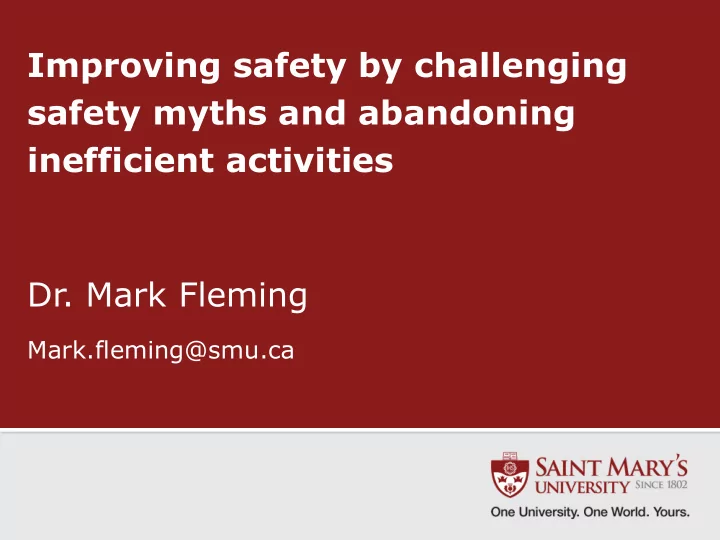

Improving safety by challenging safety myths and abandoning inefficient activities Dr. Mark Fleming Mark.fleming@smu.ca
Outline • Purpose • Challenging myths • Evaluating practices – Focus on effectiveness • Ways to improve – Better performance measures – Greater line involvement and ownership – Increasing efficiency
Purpose • Continuing to improve safety with fewer resources • Improving efficiency of hazard management is as important as effectiveness • Critical examination of current thinking is going to be central to improvement
Safety myths Target No injuries Zero = safety More rules increase safety Raising Accident awareness triangle is effective Safety is Training is top priority a control measure
Accident Triangle Fatality 1 Serious 30 injury 300 Minor Injury
Accident triangle • Proposes that minor injuries, which occur more frequently can be used an indicator of safety overall. • Overall safety performance improves by preventing minor injuries. – This assumes that all injuries have common causal factors.
To what extent is the Accident Triangle used in your organization? • Not used • Occasionally used • Frequently used
Safety improvement?
Fatal assumptions
Different hazards and causes Drowning, fall from height, vehicle, crushing Musculoskeletal, assaults, PTSD, struck by object Slips, trips, falls, burns, cuts, bumps
An alternate approach • Don’t use a triangle or pyramid when reporting injury statistics • Report potential consequences, not just the actual – Based on risk assessment consequences (1-5) • Focus on the number and type of controls that failed – What failures say about how safety is being managed
Engineering DANGER and design Rules, procedures and resources Supervision 1 Level 3 incident. and planning Employee struck knee, when jumping out of the Work practices way of a swinging load. 3 safety controls failed. • No site rules for operating in dark • No plan or direction for unloading materials • Poor work practices for working around moving loads 4 Level 1 incidents. 3 incidents From Reason 1997 occurred because 1 work practices safety control failed. 1 incident occurred because 2 controls failed
Calculating rate Potential 1 2 3 4 5 Number of 4 1 incidents Impact 4 3 Rate= (Number X Potential)/ Hours Rate= (4x1)+(1x3) / hours Rate= 7 / 50,000 Rate per 100,000 hours= 14 Control failure rate= (Control failures)/ Hours Control failure rate= 8 / 50,000 Control failure rate per 100,000 hours= 16
How open is your organization to changing safety performance measures • Not open • Somewhat open • Very open
Target zero • Increasingly popular safety aspiration • Based on admiral ideal that no one should be injured at work • Initially a response to criticisms of target injury rates – Many companies keep target injury rate for safety bonus
Problem with target zero • Focuses safety efforts on the prevention of minor injuries • Management become even more reactionary and lagging indicator focused • Loss of creditability with staff • Inconsistent with concept of risk, as no such thing as zero risk • Promote delusion of total safety • Increases risk of serious incidents
Are these activities safe? Completed without injury
Presence not absence of safety • Injury rate does not equal safety – Only provides information on a limited set of safety failures • Many other ‘leading’ indicators only capture failure • Need for indicators that assess the overall health of safety processes – The presence and quality of controls
Does your organization promote Zero Injuries as a target • Yes • No
Engineering DANGER and design Rules, procedures and resources Supervision 90% in place and planning and effective Work practices 75% in place and effective 80% in place and effective 50% in place and effective From Reason 1997
Efficiency and effectiveness • Measure safety performance not failure • Focus on high potential activities – Identify – Frequent targeted assessment – Assess the health of safety defenses • Report performance widely • Target investigation and prevention on high potential events • Adopt better safety models
Focus on core mission Core Support • Actions to control hazards • Documentation by those performing the • Risk assessment work • Investigation • Equipment design and • Management oversight maintenance • Audit • Work planning • Additional actions by • Workspace design those performing work to • PPE demonstrate rule compliance
Review current practices • Consider stopping activities that do not reduce risk – If daily job hazard analysis is not resulting in changes to risk control why do them? • Identify activities that are driven by safety, as they may not be adding value or highlight weak leadership commitment • Focus on providing expert advice
Steps 1. Review how much of your effort is being spent on supporting risk management 2. Educate leaders about the benefits of adopting a different approach 3. Adopt new performance measures 4. Engage workers to identify more efficient ways of managing hazards 5. Monitor impact of any changes
How interested would your management be in increasing the efficiency of safety • Not interested • Somewhat interested • Very interested
Improvement strategies 1. Educate leaders – Highlight gap in information about safety 2. Change the message from frequency of failure to quality of controls 3. Focus safety resources on high potential hazards 4. Involve employees – Important source of safety information
Conclusions • More safety activities is often not better safety • More efficient safety is also likely to be more effective • A focus on high potential hazards likely to be more engaging for everyone • Safety is the way we do things not something that we do
Recommend
More recommend